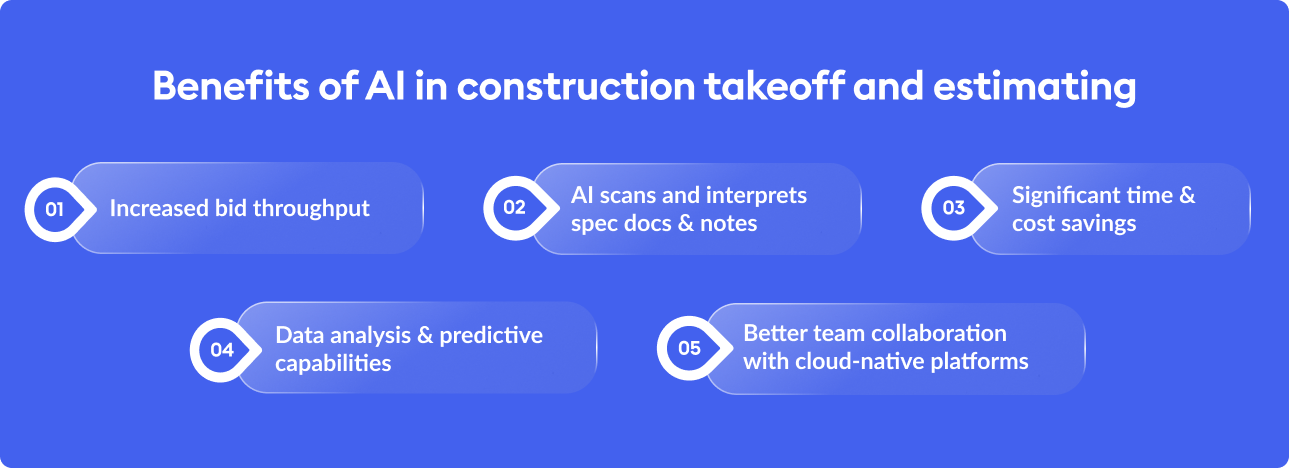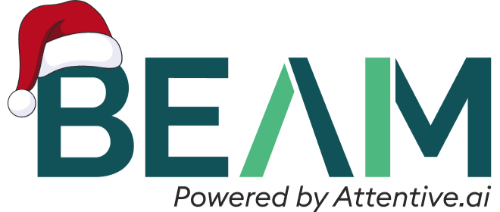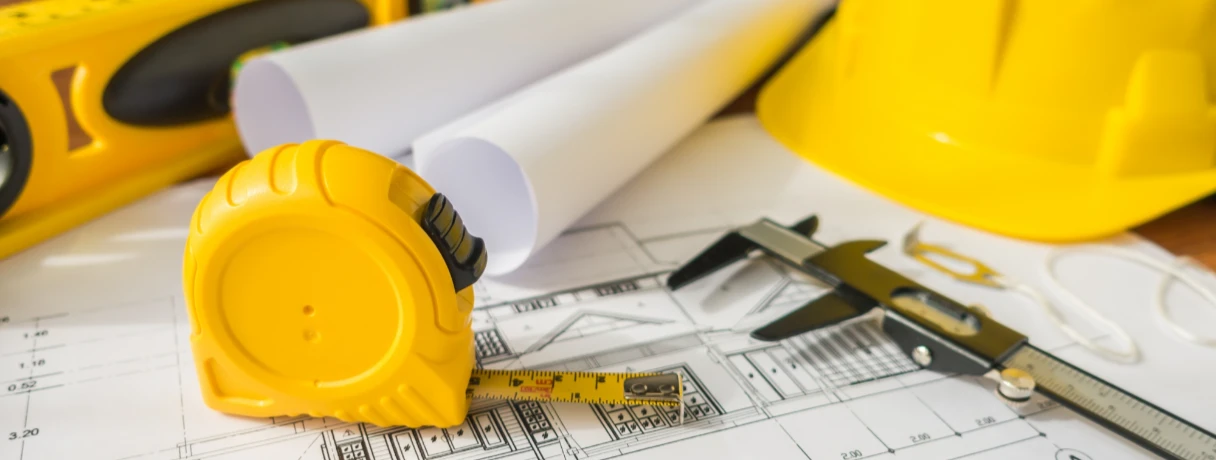Importance of AI in construction takeoff and estimating
Manually taking off quantities across large plan sets has always slowed down bidding. Estimators and project managers traditionally spent countless hours sifting through large construction plans, manually marking quantities, and double-checking measurements to ensure accuracy.
Yes, manual processes are familiar, but they are slow, repetitive, time-consuming, and prone to human error—that's why top construction businesses are adopting AI-based software to bid on more projects and increase their speed to market.
Many have already started incorporating AI in construction takeoff and estimating to save time and focus on other high-priority tasks, such as coordinating with vendors, conducting more thorough pre-bid site walks, negotiating better pricing, and more.
In this blog, we are going to cover how AI in construction takeoff and estimating is transforming traditional workflows. We’ll explore its key benefits, compare it with manual methods, discuss the rising use of genAI and LLMs in construction software, and explain why solutions like Beam AI are leading the way in preconstruction technology.
Why AI is a game-changer for construction estimators?
Modern AI-based takeoff tools don’t just digitize drawings and give you a space to do the takeoff on screen manually—they interpret plans and also do the entire takeoff for you so that you can focus on other high-priority tasks.
Let’s talk about how adopting AI-based construction takeoff software in your bidding workflow creates real, measurable advantages.

Enhanced accuracy & error reduction
Manual takeoff methods often lead to errors in material counts or measurements, which can result in costly overheads. AI-based automated takeoff solutions scan through all plan sets and specifications, auto-detect addenda, streamlining revisions, and save valuable hours. This ensures errors are noticed and curbed beforehand, and teams bid with higher confidence.
Significant time & cost savings
With traditional methods, estimators could spend hours and days on a single project. AI reduces this workload dramatically. Faster estimating enables contractors to bid on more projects, increasing competitiveness and revenue potential—all without adding additional headcount.
Irana Perez, a Civil Engineer and Project Estimator at Petticoat-Schmitt Civil Contractors, discussed with us how AI has helped her win more bids.

Read the full case study here.
Improved data analysis & predictive capabilities
AI doesn’t just automate tasks; it learns from the data you feed it. AI-based takoeffs get efficient with every project. It captures details and establishes SOPs, making it easier to perform similar takeoffs.
Moreover, with AI-based takeoffs scanning through all documents and providing accurate material and quantities, you can forecast costs, assess risks, and identify potential delays much earlier.
Better team collaboration & communication
Keeping all relevant stakeholders informed during a manual takeoff process is a nightmare. Plans are often missed, details are overlooked, and the likelihood of last-minute hiccups is always high.
AI in construction takeoff and estimating can facilitate real-time collaboration, allowing multiple team members to access and work on the same takeoff. You can:
- Give access to your takeoff to particular team members for real-time collaboration.
- Use shareable links for team reviews and for final proposals.
- Create personal copies of any takeoff to test changes and add features, without affecting the original shared version.
Key applications of AI in takeoff and estimating workflows
Automated material quantities identification
AI-based tools quickly detect walls, doors, windows, and other components, generating detailed quantity takeoffs in minutes.
Software like Beam AI, on the other hand, fully automates the material takeoff process. Here, you let AI do the heavy lifting as it reads through 100s of sheets to pick up notes & specs, factoring it in to perform takeoffs. These takeoffs, then reviewed by a QA team, are delivered to you within 24-72 hours in formats that best align with your estimating workflow.
Intelligent scope interpretation & risk assessment
AI can accurately interpret project scopes, highlight missing details, and help you flag risks early, ensuring better-informed decision-making.
Integration with BIM and digital estimating tools
Applications of AI also hold potential to integrate seamlessly with BIM (Building Information Modeling) based takeoffs. So, AI will pick up quantities from 3D models and populate your estimating templates, making it even easier for you to take data from plan to digital estimating tools.
AI vs. traditional methods: A new era of efficiency
Manual takeoffs may feel familiar and give a sense of control, but in today’s competitive construction industry, they’ve become a serious disadvantage. They aren’t scalable, limiting you to a one-project-at-a-time approach. They’re also difficult to standardize—no two takeoffs look the same—making reviews inconsistent and time-consuming.
AI-based takeoffs, on the other hand, deliver speed, accuracy, and scalability. They enable you to run multiple takeoffs simultaneously, ensuring a standardized and consistent process every time.
Let’s talk about the key differences between manual/ traditional takeoff methods and AI-based takeoffs.
Implementing AI in your estimating department
Many believe that AI will replace estimators. That is not true.
Construction businesses that adopt AI early can drastically increase their bid capacity and refocus their estimator bandwidth on tasks that require human input.
Beam AI helped Tactical Construction, a GC located in Western NY, increase their bid capacity by 2X, while also saving 50% of their time. With AI handling the takeoffs, they could pursue larger opportunities and improve turnaround confidence.
Moreover, with the time saved, Tactical Construction redirected its estimators to focus on business development, inventory management, and purchasing—high-priority tasks that require human effort.
Read the full case study: Tactical Construction x Beam AI
Estimators will always remain essential for judgment, relationship-building, and final decision-making, while AI handles the heavy lifting. The combination results in:
- Faster takeoff turnarounds
- Reduced overhead costs
- Stronger bid-win ratios
- Greater profitability
Beam AI: Best takeoff software for construction estimators
Beam AI is the ONLY AI-based construction takeoff software that saves 90% time and helps you bid on 2x more jobs, without adding headcount.
With Beam AI automated takeoffs, construction teams can:
- AI auto-reads all spec details and scope documents, so nothing gets missed
- Get bid-ready, QA-checked outputs in 24-72 hours
- Auto-detect addenda, streamlining revisions, and saving valuable hours
Let’s discuss some of Beam AI’s powerful features, which are built around estimators at their core.
Bid Dashboard
Beam AI’s bid dashboard gives you a single, organized space to track bid statuses, due dates, addenda, RFIs, and ITBs. It also sends automatic reminders ahead of every deadline—so you can finally replace messy spreadsheets and whiteboards for good.
This space also lets you create, submit, and track takeoffs within a bid—so everything you need to estimate and build a proposal is all in one place.
Resubmit takeoffs for addenda
With Beam AI, you can resubmit a takeoff in just a few clicks. The platform automatically detects plan changes and generates an updated, bid-ready takeoff. Your Excel export includes a built-in variance report with side-by-side comparisons of pre- and post-addenda. You can also toggle and view addenda changes directly on the platform.
Export Outputs
Export detailed Excel reports and PDFs, or share interactive takeoff links—customizable, high-quality outputs designed to simplify collaboration and streamline your estimation workflow.
Advanced takeoff editing toolbar
Beam AI’s intuitive editing toolbar enables you to quickly make edits to your takeoff, featuring drawing, measuring, selecting, and markup tools.
The list does not end here. Check out the complete set of features here.
The Future of AI in Construction
AI is shaping the next wave of preconstruction technology. These innovations can now fully automate takeoffs, eliminating manual effort entirely. Not only will this expedite the bidding process, but it will also conserve the estimator's bandwidth, free up time for other high-priority tasks, and enable construction businesses to pursue larger revenue opportunities.
As adoption accelerates, AI in construction takeoff and estimating won’t just be a competitive advantage; it will become a standard feature of every construction tech stack. For contractors and estimators, the message is clear: the future belongs to those who embrace AI today.










.webp)



.webp)

